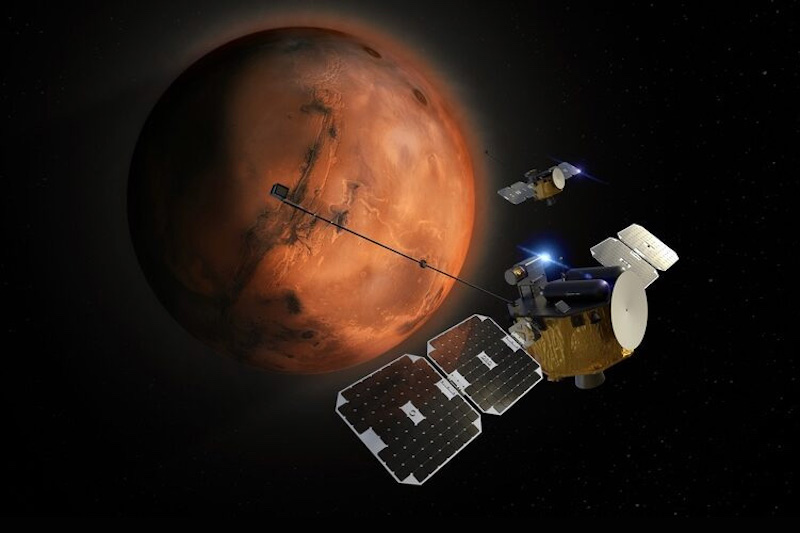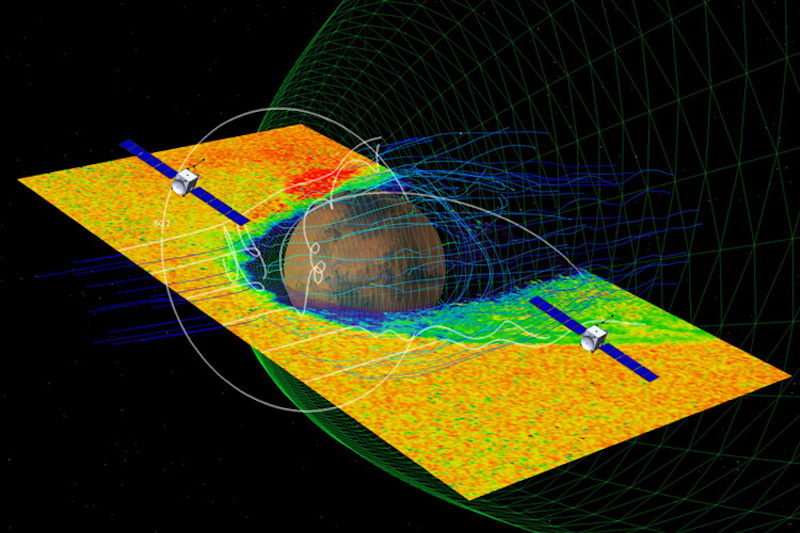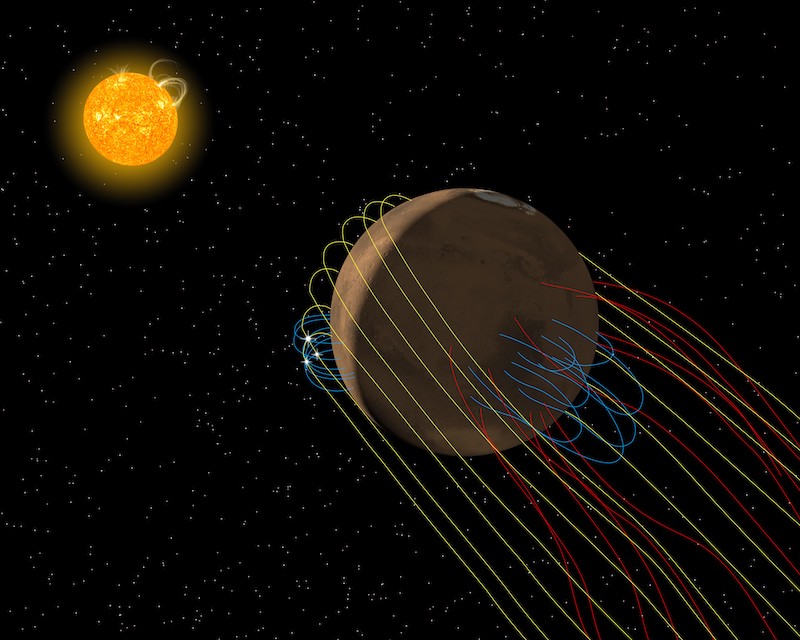
Blue and Gold orbiters
Mars is a busy place these days. There are currently eight active orbiters at Mars, originating from the U.S., Europe, Russia, India and China. In late August 2021, Miles Hatfield wrote in a NASA blog post that two more orbiters will be joining the fleet. Dubbed Blue and Gold, they’re part of NASA’s ESCAPADE mission, and they’ve just passed mission review. They’re due to launch in 2024.
Help EarthSky keep going! Please donate what you can to our annual crowd-funding campaign.
ESCAPADE stands for Escape and Plasma Acceleration and Dynamics Explorers. The University of California, Berkeley, is taking the lead on the mission. It’ll study Mars’ magnetosphere and atmosphere, and the solar wind.
The recent mission review – called Key Decision Point C – ended August 17. So now the mission has moved into its next phase. Specifically, the coming phase will include the final design and building of the instruments that’ll ride aboard the Blue and Gold orbiters. As Rob Lillis at UC Berkeley, principal investigator for ESCAPADE, said in the NASA blog:
We are thrilled to pass this critical milestone, the culmination of two years of science and engineering work from a talented and dedicated team at UC Berkeley and our partners. We’re very excited to now move towards final designs, assembly, test, launch and get on our way to Mars.

ESCAPADE is a smallsat
ESCAPADE is what’s known as a smallsat mission. According to NASA, that’s a spacecraft with a mass less than 180 kilograms (about 400 lbs). It’s in contrast to, say, NASA’s Mars Reconnaissance Orbiter, which was 2,180 kilograms (4,810 lbs) at launch. Or it’s in contrast to the Mars Science Laboratory mission, which delivered the Curiosity rover to Mars. It had a launch mass of 3,839 kilograms (8,463 lbs).
ESCAPADE’s two identical orbiters are being developed by Rocket Lab. The Blue and Gold satellites will ride to Mars on Rocket Lab’s Photon bus, originally designed to launch payloads into Earth orbit. Each of the orbiters is weighs no more than 120 kilograms (about 250 lbs), excluding fuel. So each one is about the size of a mini-fridge. By making the whole package small, costs will be kept to a minimum, NASA has said, while a lot of science can still be produced. According to Peter Beck, founder and CEO of Rocket Lab:
This is a hugely promising mission that will deliver big science in a small package. Our Photon spacecraft for ESCAPADE will demonstrate a more cost-effective approach to planetary exploration that will increase the science community’s access to our solar system for the better. I’m thrilled that the hard work and dedication of the engineering teams at UC Berkeley and Rocket Lab to date have paid off and the mission has been approved by NASA to begin final design and building.
As Lillis also commented in Berkeley News:
ESCAPADE and two other NASA missions recently approved are experiments to see whether advances in the space industry over the last five to 10 years can translate to a much better bang for the buck in terms of science per dollar. Sending two spacecraft to Mars for the total cost of under $80 million is just unheard of, but current NASA leadership is taking the risk.

Alan Zide, program executive for the mission at NASA headquarters, added:
For ESCAPADE, we’re evaluating a number of rideshare options to enable this critically important science while also lowering costs.
Studying Mars’ magnetosphere, atmosphere and the solar wind
So what will ESCAPADE do at Mars? Its primary mission is to study the planet’s magnetosphere, how it interacts with the solar wind and the processes driving its atmospheric escape. More specifically, it will analyze how Mars’ magnetic field guides particle flows around the planet and how energy is transported from the solar wind. It will also determine what processes control the flow of energy and matter in the atmosphere.
As noted by Shannon Curry, project scientist for the mission at UC Berkeley:
This constellation of two satellites at Mars will answer big questions about the atmosphere and the solar wind in real time.
Lillis also said that:
With simultaneous two-point observations, ESCAPADE will bring us the first ‘stereo’ picture of this highly dynamic environment.

Space environments around planets
The mission is part of NASA’s plan to better understand the space environment around different planets in the solar system, as Jared Leisner, ESCAPADE program scientist, explained:
Our heliophysics decadal surveys have identified the scientific need to study the space environments of other planets. By studying the same processes at different planets, we gain key insights into how they function both at Earth and at other planets beyond the solar system.
Joy and happiness
The mission team is, of course, excited about the upcoming journey to Mars. Indeed, and unsurprisingly, Lillis said that his reaction to ESCAPADE passing the last review was
Just unbridled joy and happiness.
Last February, researchers announced that Mars’ atmosphere is shedding charged particles that then accumulate on the planet’s largest moon, Phobos. ESCAPADE may be able to study this phenomenon more as well.
Bottom line: NASA’s ESCAPADE mission, consisting of the two Blue and Gold orbiting satellites, has passed its final mission review. It will head to Mars in October 2024.











